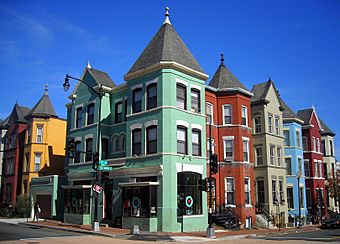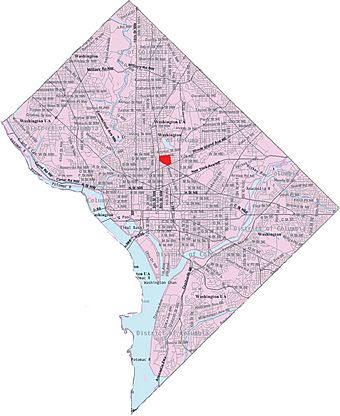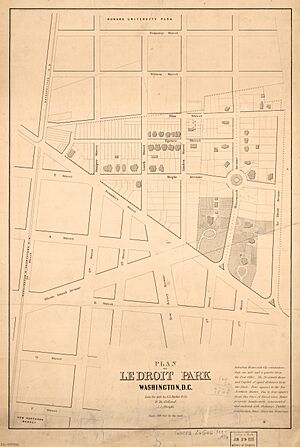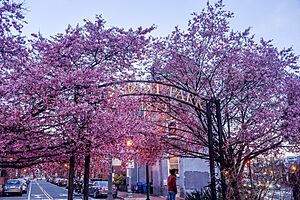LeDroit Park facts for kids
Quick facts for kids |
|
|
LeDroit Park Historic District
|
|

Intersection of 4th & T Streets, NW in LeDroit Park (2008)
|
|

Map of Washington, D.C., with Le Droit Park highlighted in red
|
|
| Location | Bounded roughly by Florida, Georgia, and Rhode Island Avenues, 2nd and Elm Streets, NW, Howard University, Washington, D.C. |
|---|---|
| Built | 1873 |
| NRHP reference No. | 74002165 |
| Added to NRHP | February 25, 1974 |
LeDroit Park is a cool neighborhood in Washington, D.C.. It's right next to Howard University. This area is famous for its long history and its amazing 19th-century buildings. Many people love living here because it's a diverse community. It's also super close to the Shaw–Howard University Metro station and lots of places to eat!
Contents
History of LeDroit Park
LeDroit Park was started in 1873 by a businessman named Amzi Barber. He was on the board of trustees for Howard University. Barber named the neighborhood after his father-in-law, LeDroict Langdon. He just dropped the letter 'c' from the name.
How LeDroit Park Began
This neighborhood was one of the first "suburbs" of Washington, D.C. It was designed to feel like a "romantic" escape. The streets were narrow and lined with trees. In fact, the streets were named after the trees that grew there! This was different from how other streets in the city were named. A lot of money was spent to make the area beautiful. They planted many flower beds and trees. This was done to attract important people from the city to live there.
Changes Over Time
When it first started, LeDroit Park was only for white residents. It even had gates and guards to keep people out. But students from Howard University and others worked hard to change this. They wanted the area to be open to everyone. Between 1886 and 1891, there was a "fence war." This was a fight between residents and people who wanted to pass through the neighborhood. Eventually, the streets were opened up. LeDroit Park then became more connected to the rest of the city.
By the 1940s, LeDroit Park became a very important place for famous African-American leaders. Many well-known people lived there. Griffith Stadium was also in LeDroit Park. This was a big sports stadium where the Washington Redskins and Washington Senators used to play. In 1965, Howard University Hospital was built where the stadium once stood. You can also find Anna J. Cooper Circle in LeDroit Park. It's named after a pioneer in education.
LeDroit Park's Historic Status
Today, LeDroit Park is officially recognized for its important history. It's called the LeDroit Park Historic District. This district includes the Mary Church Terrell House, which is a U.S. National Historic Landmark. In 1974, the neighborhood was added to the National Register of Historic Places. This means it's a special place that is protected for its history.
Exploring the Heritage Trail
On October 17, 2015, the LeDroit Park Heritage Trail opened. It was created by Cultural Tourism DC. This trail is a walking tour with 16 signs. It takes about 90 minutes to walk. The signs tell the story of the neighborhood and the people who lived there. The trail starts where Florida Avenue, 6th Street, and T Street meet. This spot is like the "gateway" to LeDroit Park.
Architecture and Unique Homes
One of the most special things about LeDroit Park is its beautiful Victorian homes. These include mansions, houses, and row-houses. They were all designed by an architect named James McGill. What's really cool is that none of the first 64 homes McGill designed were exactly alike! Most of them were built between 1873 and 1877. Today, 50 of these original homes are still standing. McGill was also part of a group that looked after the properties in LeDroit Park. Today, there's a similar group called the LeDroit Park Civic Association. The neighborhood has 12 different styles of protected homes.
Public Spaces and Art in LeDroit Park
When the Gage-Eckington Elementary School closed, people living in the area worked hard to turn it into a park. They succeeded! The park opened in 2011 and is called The Park at LeDroit. It has a big playground for kids and a special area for dogs. There's also the Common Good City Farm. This farm teaches people about growing food in the city. It has 40 garden plots for the community. In May 2011, Prince Charles from the United Kingdom even visited the Common Good City Farm!
Neighborhood Murals
You can see colorful murals painted on many walls around the neighborhood. One mural is called This Is How We Live. It was painted by artist Garin Baker. This mural shows the African-American history of the neighborhood. It also shows how the community and landscape have changed. You can see historical and architectural scenes from the past and present. When the mural was dedicated in 2008, Mayor Adrian M. Fenty said it would "visually engage residents through a beautiful neighborhood mural that depicts the unique landscapes, people and images of the historic LeDroit Park community. The mural will become a prominent landmark in the neighborhood for years to come."
Famous People Who Lived Here
Many important and interesting people have lived in LeDroit Park:
- General William Birney – A hero from the Civil War.
- Senator Edward Brooke – The first African-American to win a Senate seat by popular vote. He was born here in 1919.
- Dr. Ralph J. Bunche – The first African-American to win the Nobel Peace Prize. He lived here while teaching at Howard University.
- General Benjamin O. Davis Sr. – The first African-American general. His son, Benjamin O. Davis Jr., led the famous Tuskegee Airmen in World War II.
- Hon. Oscar De Priest – The first Black congressman after the Reconstruction era. He lived here during his time in office.
- Paul Laurence Dunbar – A famous Black poet and a graduate of Howard University.
- Duke Ellington – A legendary jazz musician. He lived here with his family when he was a child.
- Major Christian Fleetwood – One of the first Black soldiers to receive the Medal of Honor.
- Julia West Hamilton – A community leader.
- Rev. Jesse Jackson – A well-known civil rights activist.
- Ernest Everett Just – A biology professor and researcher who made big contributions to zoology.
- Dr. Jesse Lawson and Dr. Anna J. Cooper – Both were important educators. They started Frelinghuysen University to teach working-class Black adults. Dr. Lawson was also a lawyer who fought for the rights of poor people in D.C.
- Mary Church Terrell – An activist who fought for civil rights and women's right to vote. Her house is a National Historic Landmark.
- Walter Washington – The first mayor of D.C. elected by the people.
- Clarence Cameron White – A notable educator in fine arts and a Howard University graduate.
- Dr. Garnet C. Wilkinson – He was the Superintendent of Colored Schools during the time of segregation.
- John W. Garland – A former president of Central State University.
Images for kids





